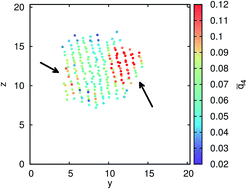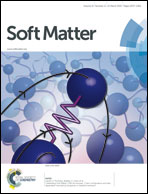Two-stage crystallization of charged colloids under low supersaturation conditions
Abstract
We report simulations on the homogeneous liquid–fcc nucleation of charged colloids for both low and high contact energy values. As a precursor for crystal formation, we observe increased local order at the position where the crystal will form, but no correlations with the local density. Thus, the nucleation is driven by order fluctuations rather than density fluctuations. Our results also show that the transition involves two stages in both cases, first a transition of liquid → bcc, followed by a bcc → hcp/fcc transition. Both transitions have to overcome free energy barriers, so that a spherical bcc-like cluster is formed first, in which the final fcc structure is nucleated mainly at the surface of the crystallite. This means that the second stage bcc–fcc phase transition is a heterogeneous nucleation in the partially grown solid phase, even though we start from a homogeneous bulk liquid. The height of the bcc → hcp/fcc free energy barrier strongly depends on the contact energies of the colloids. For low contact energy this barrier is low, so that the bcc → hcp/fcc transition occurs spontaneously. For the higher contact energy, the second barrier is too high to be crossed spontaneously by the colloidal system. However, it was possible to ratchet the system over the second barrier and to transform the bcc nuclei into the stable hcp/fcc phase. The transitions are dominated by the first liquid–bcc transition and can be described by classical nucleation theory using an effective surface tension.


 Please wait while we load your content...
Please wait while we load your content...